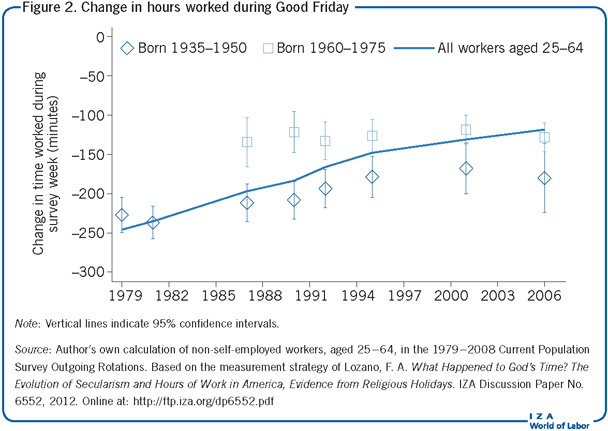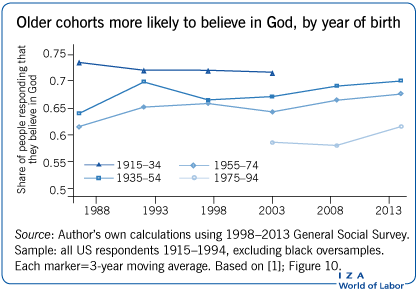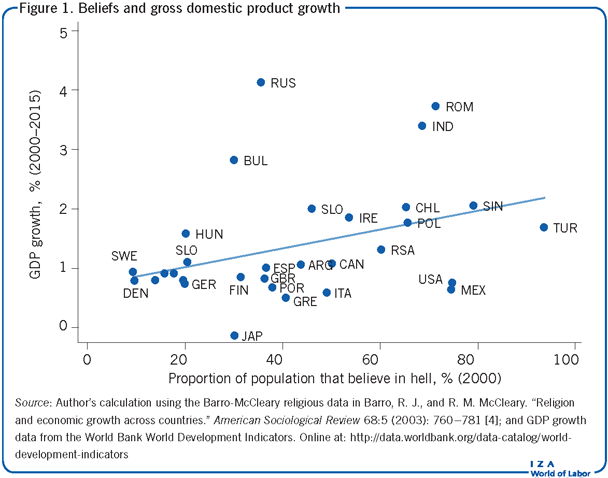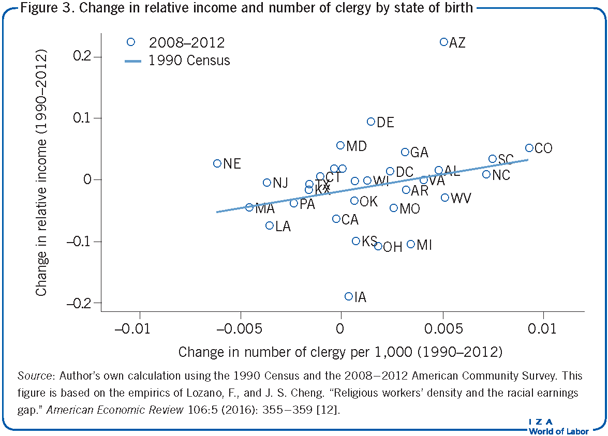Elevator pitch
The literature on the economics of religion finds that increased religious participation or religious density is associated with positive socio-economic outcomes such as increased earnings, educational attainment, and lower engagement in risky behaviors. The literature suggests that this relationship is causal, and that the gains from religion often tend to be accrued among low-skill or marginalized youth groups. In turn, as education and income increase, societies become more secular. Will the positive outcomes associated with religion disappear as western societies become more secularized?
Key findings
Pros
Cross-country data suggest a positive relationship between religious participation and economic growth, yet this relationship decelerates as religiosity increases.
Using individual data, religion is positively associated with socio-economic outcomes, and the association is strongest among high risk or marginalized populations.
A plural market for religion, i.e. the coexistence of multiple religions in a country, increases religious participation, and potentially religious beliefs indirectly.
Research based on individual data suggests that religious beliefs associated with positive socio-economic outcomes may be enhanced through religious participation.
Cons
A state religion results in a lower quality of religious services and a lower preponderance of religious beliefs among individuals, although it may result in more participation.
Religion and religiosity are multi-dimensional and difficult to quantify.
Increased secularization may result in societies forgoing any benefits associated with religious beliefs and participation.
Research shows that increased secularization results in higher engagement in riskier behavior (e.g. drug and alcohol consumption).
Author's main message
From a policy perspective, it is essential to pursue a diverse and competitive market for religion by rejecting the idea of a state religion. The empirical literature demonstrates that pluralism increases religious participation, and that, in turn, religious participation is associated with better socio-economic outcomes at the individual level. To motivate a pluralistic religious landscape, governments should encourage freedom of beliefs and practices. Two possible mechanisms to create such a plural religious landscape are to promote interfaith dialogue and to prevent religious discrimination.
Motivation
Karl Marx is famously paraphrased as writing that “Religion is … the opiate of the masses.” While economic research suggests that there is no empirical evidence to support this statement, it does suggest that religion is associated with improved labor market outcomes, better educational attainment, and lower engagement in risky behavior among youth. Yet, economic research also suggests that as personal income increases, societies become more secular, which in turn dissipates the positive association between religion and socio-economic outcomes.
Discussion of pros and cons
At the macro level, cross-country comparisons used in the literature to explore the association between economic growth and religion suggest two seemingly contradictory empirical issues. The first is that there is a positive association between religion and economic growth—that more religious societies experience faster economic growth. The second result is that when economic growth or income is the explanatory variable, increases in income are associated with less religious participation, and reduced religious beliefs. This second empirical result is known as the secularization hypothesis.
A second econometric issue when estimating the relationship between religion and income is the nature of religion and how to measure it: should the researcher concentrate on religious beliefs, religious attitudes, or religious practices? Further, most surveys record self-assessed measures of religion. It is possible that respondents over- or underestimate their attendance at religious activities, or their involvement with religion.
The coexistence of these two empirical issues complicates the correct estimation of the relationship between economic growth and religion, as it is not clear which way the causality operates: Do religious attitudes, practices, and beliefs increase income? Or do increases in national income decrease religion? Pinning down this relationship is the challenge of the economist.
The two most likely explanations for the positive relationship between religion and economic outcomes are: (i) religion is associated with positive attitudes that promote economic growth, for example social norms such as cooperation, property rights enforcement, lower engagement in risky behavior, or better saving habits [2]; or (ii) the so-called “club goods theory of religion.” This suggests that, at the local level, religious organizations work as a social safety net, where the community provides role models and the members of the group support each other in mutually insuring against negative shocks: finding jobs, securing housing, or where the religious institution provides public goods [3].
Religion and economic growth-Cross country analysis
The effect of religion on economic growth has been widely explored, and in general found to be positive [3], [4]. For example, a study exploring a cross-section sample of countries between 1965 and 1990 shows estimates that are positive, but not across all measures of religious beliefs and religious participation. The authors analyze three variables describing religion: monthly church attendance, belief in heaven, and belief in hell. Their results show that for a given level of religious attendance, belief in hell or in heaven is associated with higher economic growth. In contrast, for a given level of beliefs, religious attendance is negatively associated with economic growth. These results strongly suggest that religion enhances personality traits that are associated with economic growth such as a strong work ethic, honesty, and cooperation. However, they also show that religious attendance may crowd out workers’ time from labor or other productive activities [4].
Figure 1 shows this relationship between economic growth and religion, using the proportion of individuals who report that they believe in hell. This relationship is positive and statistically significant. However, this does not hold if instead the explanatory variable refers to religious participation such as frequency of prayer or attendance at services. In addition, while the association between religion and socio-economic outcomes is positive, it is important to note that this relationship increases at a decreasing rate. That is, as income increases, workers substitute away from religious activities, as the opportunity cost of religion increases because of the higher implicit cost of time due to potential earnings forgone [5]. It is important to note, nonetheless, that the countries in Figure 1 might be at different stages of development. That is, countries that show higher propensity to believe in hell tend to be (with the exception of the US) more recently industrialized, compared to those countries with low propensity to believe in hell, which are mostly western EU countries.
Moreover, after controling for level of growth and development, religion does not uniformly affect future economic growth. Instead, research shows that a country’s religious infrastructure matters, and it is important to differentiate between a plural and free market for religion, and a state religion [6]. A definition of state religion may be where the state sponsors an official religion, where the state appoints religious officials, or where the state’s infrastructure promotes a single religion. The main result in this research is that competition among religions increases the quality of religious services provided. In contrast, the quality of services under a state religion suffers due to the lack of competition, even though religious participation may increase—which is not necessarily linked to economic growth.
In summary, under a religious infrastructure that promotes pluralism and religious freedom, the quality of religious services is enhanced. Plural religious institutions are thus associated with economic growth to the extent that better religious services model people’s beliefs towards those associated with traits such as cooperation, a positive work ethic, or thrift. In contrast, the presence of a state religion suggests an increase in religious participation, but not in religious beliefs. The literature shows that beliefs such as those in hell, an afterlife, or God decrease as the state attempts to regulate religion [6].
Religion and personal well-being—Individual data analysis
While cross-country comparisons allow researchers to understand differences between religious beliefs and religious participation, and their effects on economic growth, one shortcoming is the lack of clarity of the mechanisms that may explain this relationship. Research that is based on individual data helps understand these mechanisms.
Measuring the relationship between religion and labor market outcomes is empirically challenging when using individual data. The challenge arises because religious beliefs, religious participation, and labor market outcomes are all associated with personality traits that are often unobserved by the investigator. In that sense, observing a positive association between religious participation and labor market outcomes may be biased due to unobserved factors, and will confound the true relationship between these two variables. For example, these unobserved factors may be: discipline, a strong work ethic, and entrepreneurial abilities, and may be positively correlated with religion and economic outcomes simultaneously. It may very well be possible that individuals who are not religious or do not have access to religious institutions, but share these latter characteristics, will have the same positive economic outcomes as those individuals who report high religious participation or beliefs. The challenge to the researcher is that of the unobserved counterfactual or control group. The microeconomic literature around the economics of religion is focused on identifying the causal mechanisms in which religion operates independent of other individual characteristics.
Just like cross-country comparisons, individual data show that the western world (in particular the EU and the US) is increasingly becoming more secular. Using data for the US, research that looks at the determinants of religious participation shows that as income increases, the opportunity cost of religion increases, which in turn decreases/lowers participation, and that church membership is inversely correlated with income [5].
Use of individual data also enables a different approach, where market-revealed preferences toward religion are utilized, instead of self-reported data on religiosity or religious participation. For example, Figure 2 uses labor market data to look at absenteeism from work during religious holidays. This figure suggests that American workers are now increasingly more likely to work on Good Friday compared with 30 years ago.

One of the challenges to understanding the secularization hypothesis is to differentiate between a time trend, or period effects, and differences across generations, or cohort effects. The illustration on page 1 differentiates between period effects and cohort effects. It shows changes in the answer to the question “Do you believe in God?” during the last 30 years, and that these changes are mostly across cohorts, but not across time. The figure shows that especially younger cohorts, most obviously those born between 1975 and 1994, are less likely to believe in God than older cohorts.
However, self-assessed responses on one’s own religious beliefs might include heuristic biases that are unobserved by the researcher. Instead, it may well be worthwhile to look at market-based measures. Figure 2 shows the reduction in the number of minutes worked on Good Friday in the US, and suggests a secular decrease in this metric over the last 30 years across cohorts. Dividing the data across cohorts, however, shows a very different story. First younger workers are less likely than older workers to take time off from work during Good Friday; but while the trend is fairly stable among younger workers, there is also a secular decline in work absenteeism among older workers. The data suggest a change not only across cohorts, but also within cohorts across time.
Another interesting fact shown by the individual data is that religious attendance rises sharply with education. However, across denominations religious attendance is greatest among those denominations with less-educated members. This puzzle highlights the importance of social networks within each congregation, where individuals with more education use religion as a form of social interaction [7]. These results highlight that individuals use religious institutions to provide inputs into a collective good, be it to protect against negative labor market shocks or to create a safety net. To avoid free-riding, religious institutions usually incorporate behaviors that entail stigma and sacrifices into their practices. This has been referred to in the literature as the club goods theory of religion [3].
There is a large empirical literature exploring the club goods theory of religion. The financial crisis in Indonesia presents a good example of religion being used as a semi-formal method of insurance by households. Indonesia’s financial crisis in 1997 and 1998 resulted in an Islamic resurgence among households that were more vulnerable to negative financial shocks. Households that expected high volatility in their income were more likely to study the Koran or to enroll their children in madrasas. These religious institutions gave households access to credit markets that they otherwise would not have had [8]. This relationship is not only true in Indonesia and with Islam, but similar research among households in the US shows that those who give more to religious institutions are also better able to insure against income shocks.
Religious participation and beliefs also enhance human and social capital. There is a large literature showing that religious participation enhances labor market outcomes and human capital such as higher income, educational attainment, and achievement. Moreover, religion decreases welfare receipt and engagement in risky behaviors, such as drug use, drinking, and crime. For researchers, the challenge is to measure religious participation independently from other personal characteristics that might be driving the positive outcomes. To do so, research in the US uses market density, measured as the proportion of individuals in the respondent’s local area whose ancestry is linked to the respondent’s religion, to estimate religious participation [9]. The results suggest that living among a high density of one’s ancestry is negatively related to labor market outcomes, but living among a high density of one’s religious ancestry is associated with better labor market outcomes. This result suggests that, to the extent that one’s religious ancestry is independent from unobserved characteristics such as drive or entrepreneurship, religion does have a positive and causal effect on labor markets.
A good example that shows the role that religious participation has in social capital accumulation is the lottery in Pakistan for obtaining visas to visit Mecca during Hajj [10]. Every year, potential pilgrims in Pakistan who want to visit Mecca during Hajj must apply to a lottery because Saudi Arabia limits the number of visitors from each country. Ex-ante, unobservable characteristics must be distributed the same across lottery participants, yet not all of them get to go. What is relevant in this research is that, ex-post, pilgrims that go to Mecca are more likely to have enhanced Islamic practices, and to believe in principles such as peace, tolerance, and gender equality. This study is evidence of how religious participation may also mold religious beliefs that can be associated with economic growth.
Figure 3 shows another dimension of the club goods theory of religion: The positive association between religion and outcomes is particularly true for vulnerable, marginalized populations. A study of US inner city youth in the 1980s shows that churchgoing provides quite a good predictor of school attendance, work activity, and engagement in risky behavior such as drugs and alcohol consumption [11]. While looking at the relationship between interrelated outcomes and churchgoing is likely biased, as both behaviors are associated with other potentially unobservable characteristics. Figure 3 presents a strategy that uses labor markets to explore this relationship. The strategy is to use the change in the number of religious workers and the change in relative outcomes for African Americans in the US. This allows one to identify the effect that being born in an area with high religious density has on future labor market outcomes, essentially using within-market changes in religious density, keeping constant other confounding characteristics. The results suggest that being born in an area with a relatively high number of religious workers is associated with higher wages for African Americans in the US relative to non-Hispanic whites [12].
Just as religious beliefs and participation are associated with better labor market and other demographic outcomes, increased secularization is associated with worse outcomes and, especially, increased engagement in risky behavior. To evaluate the economic and socio-economic outcomes associated with secularization, researchers have used the repeal of blue laws—laws designed to enforce religious standards—in many US states. For example, one study shows a decrease in completed education and adult wages with the repeal of blue laws [13].
Limitations and gaps
Estimates of the association between religion and socio-demographic outcomes tend to be confounded by reverse causality. When religion is an explanatory variable, national income and economic growth have a positive relationship. However, when the socio-economic characteristics are the explanatory variable, then the relationship with religion tends to be negative.
There are considerable limitations across studies when measuring religion, as different empirical examinations are not consistent with respect to the various dimensions of religion. For example, the relationship between economic growth and religion suggests different results when religion is measured as participation compared to when it is measured as beliefs.
Moreover, most research is based on western, economically advanced societies, and there is little research that explores the developing world. While some research exists that focuses on the developing world, researchers still lack a clear mechanism of bridging both strands of research, which would provide for a more complete understanding of religion and economics.
Finally, there is no counterfactual to compare with. Empirical microeconomic analysis lacks the availability of a suitable control group. Ideally, research will compare the effects of a certain metric of religion on a given outcome for a group of individuals, and compare it with individuals who in all other dimensions are equivalent but who were not exposed to the religious intervention. However, such a counterfactual does not exist.
Summary and policy advice
The consensus of studies that examine the demand for religion is that the US and other western societies are becoming increasingly more secular. Importantly, the results in the economics literature suggest that secularized societies will not accrue the benefits that are usually associated with religion. Economists have shown that benefits from religious beliefs and participation span a range of labor market and demographic characteristics: from higher employment, to higher educational attainment and achievement, and to a lower engagement in risky behavior. Moreover, these benefits are particularly accrued by marginalized, disadvantaged communities.
The research shows that the quality of religious services, and with it religious beliefs and participation, increase when markets for religion are plural and free. As such, it is essential that policymakers promote and defend spaces for religious freedom, and that the infrastructure of the religious landscape in societies allows for competition across different religious denominations and providers.
Acknowledgments
The author would like to thank an anonymous reviewer and the IZA World of Labor editors for many helpful suggestions on earlier drafts.
Competing interests
The IZA World of Labor project is committed to the IZA Guiding Principles of Research Integrity. The author declares to have observed these principles.
© Fernando A. Lozano
Religious definitions and terms
Secularization: Declining participation in religious activities and decline of individual religious beliefs.
Secularization hypothesis: Economic development results in individuals decreasing their religious participation, as well as their religious beliefs. The common wisdom tends to think of the US as an exemption to this hypothesis, but data consistently show, that like the rest of the western world, the US is becoming increasingly secular.
Religion market model or supply theories of religion: Supply theories study the market of religion, as well as the infrastructure of religious life in societies. Their focus includes the benefits from pluralism and religious freedom, and whether the government influences religion through a religion of state or by appointing religious leaders.
Demand side of religion: These theories span issues around the demand for religion, religious services, and secularization. Demand side theory also includes the influence of religion on public life, policy, and government. The secularization hypothesis is a demand side theory.
Club goods models: Religious institutions work as systems of mutual insurance, providers of public goods, or social safety nets. To avoid free-riding from members, these institutions levy costs on membership such as beliefs and practices that might be highly stigmatized, unusual, or that involve some type of sacrifice.
Religious data: Most data on religious beliefs and religious participation are from the World Values Survey, the International Social Science Program, or the General Social Survey. Examples of variables for religious beliefs are: belief in heaven, belief in hell, belief in God, belief in afterlife, belief that the Bible is literal truth, or belief that adversity is punishment for sins. Data on religious participation are: weekly attendance, monthly attendance, or annual attendance. Other sources of data are the churches and church membership in the US, as well as Gallup polls. A final set of variables available in these sources is religious aggregates among different religions and denominations.


